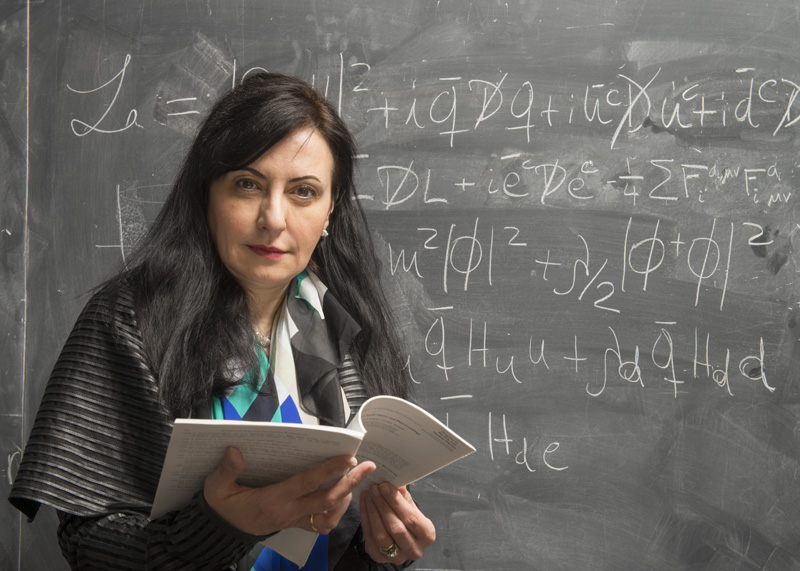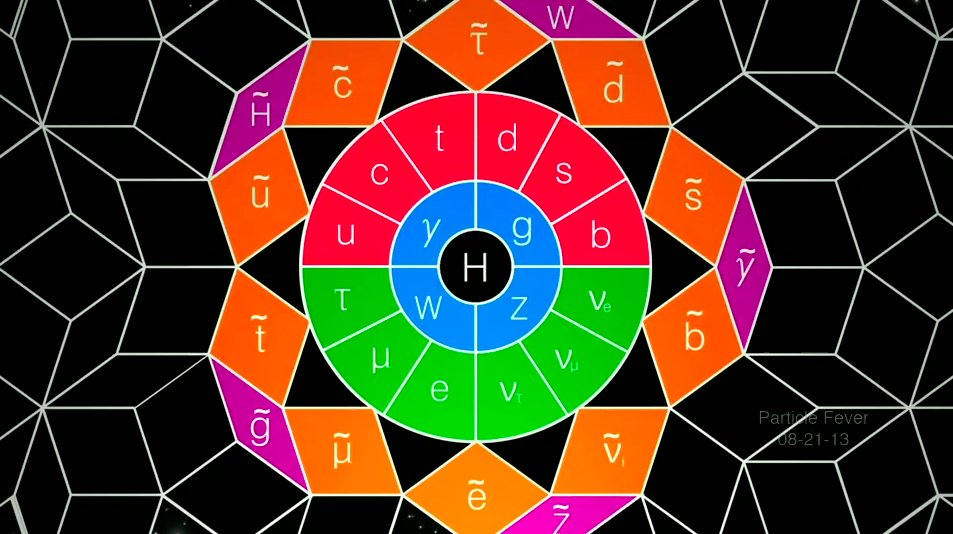![]() An interview with Marcela Carena
An interview with Marcela Carena
by Panos Charitos (CERN)

(Image credit: Marcela Carena, Fermilab)
Marcela Carena, born in Buenos Aires in Argentina, completed her PhD at the University of Hamburg in 1989. Carena is the head of the Theoretical Physics Department of Fermilab - the Fermi National Accelerator Laboratory near Chicago, Illinois, and a professor in the Physics Department and the Enrico Fermi Institute at the University of Chicago.
Carena is one of the leading physicists in theoretical high energy physics and has worked particularly on possible extensions of the Standard Model of particle physics, on the explanation of the matter/anti-matter asymmetry in the Universe, and on the origin of dark matter. She works closely with experimental physicists, creating and implementing strategies for testing the possible existence of a new symmetry of nature and new physics models that may imply that the Higgs is a composite of other constituents.
What motivated you to study physics?
I first thought seriously about pursuing a career in math and physics when I was in high school. My math teacher was a charismatic woman whose passion for what she was teaching got me excited about the art of solving challenging problems. She told me about the Balseiro Institute in the mountain city of Bariloche, which is a unique place in Argentina to study physics. A few years later I started studying engineering in Buenos Aires, but during my second year I decided to also take a few courses in philosophy. It was only in my third year of college that physics became the merger of the two. I was fortunate to be admitted to “El Balseiro” that year which I finally attended.
Which is the most exciting aspect of your present role at Fermilab?
Just yesterday our group had an exciting meeting with Fermilab experimental physicist Juan Estrada and his team about novel technologies that they are developing that could allow to detect dark matter in a new way. We brainstormed about what kinds of theories of dark matter could be probed using this breakthrough. It is exciting to be in a lab with such a diverse international community of people brought together by their common interest in science. As head of our theory group, as well as in my international role, I have the opportunity to reach out to brilliant young people who are just starting their research and bring them to Fermilab.
What have we learned from the discovery of the Higgs boson? Does it close a chapter in modern physics?
The Higgs boson discovery was more than the discovery of a new particle; it confirms that there is an invisible force field that permeates our entire universe, and gives mass to the electrons and quarks that make up everything from the stars in the sky to the spoon that you use to eat your cereal. This discovery opens a new door for modern physics, since the Higgs boson is a type of particle never seen before. By studying it now in great detail at the LHC and future experiments, we can probe the answers to many mysteries.
For example, how does the Higgs field communicate directly with dark matter, the dominant form of matter in the universe, whose existence has been so far only established by the gravitational effects of dark matter in the cosmos.
Is the Higgs responsible for the fact that our universe favors the existence of matter over antimatter? To answer this question, we need to probe experimentally how the Higgs boson interacts with itself, which is very challenging.
This is also linked to the “hierarchy problem”, which stems from the fact that there is a large hierarchy of sixteen orders of magnitude distance between the Planck mass (related to gravity) and the electroweak scale (related to the Higgs), while the quantum physics inherent to the Higgs field implies that the two scales should be similar. Only the cosmological constant has perhaps more mystery of such large discrepancies compared to expectations.
Does supersymmetry answer these questions?
The discovery of the Higgs boson and some of the open questions about our Universe point to the existence of new physics. In that sense, supersymmetry is one of the theories that could describe the new physics that lies beyond the Standard Model.
It predicts additional heavier partners for each of the known particles of the Standard Model. Adding these superpartners, effectively doubles the number of particles in nature. This is analogous to the addition of anti-particles in the standard quantum field theory; a move that also doubled the spectrum. The quantum effects of the known particles and their supersymmetric partners on the mass of the Higgs cancel each other out and thus the expected Higgs mass is consistent with the mass observed at the LHC. Hopefully these supersymmetric particles are not too far away from the electroweak scale so that the theory can be tested at colliders.

The particles in the standard model make up the inner circle. Their supersymmetric partners make up the outside ring. (Image Credit:YouTube/Particle Fever)
Dealing with the hierarchy problem has been one of the original motivations for introducing supersymmetry at low energy scales, of the order of a TeV. Moreover, supersymmetry is an attractive extension as it can tackle many other questions in a mathematically elegant way. These include the nature of dark matter, the matter/antimatter asymmetry and the tiny masses of neutrinos.
Are there alternative ways to address these open questions?
Compositeness is the other popular direction to explain the mass of the Higgs boson. Instead of adding extra supersymmetric particles, the theory suggests that the Higgs boson is not a fundamental particle but is instead made of other fundamental particles - like the pions in the case of Quantum Chromodynamics (QCD). Composite Higgs models are speculative extensions of the Standard Model where the Higgs boson is the result of a new strong force.
Composite Higgs theories may materialize in many different realizations of extended global symmetries in nature. Although they may not be at first sight as appealing as the supersymmetric guiding principle one has to look to the data and what nature tells us. Perhaps, one of the main “advantages” of compositeness is that it has many similar characteristics to QCD and we could use similar tools to advance studies for a composite Higgs.
Fermilab recently launched a rigorous research program on neutrino physics through LBNF/DUNE. Which is the key motivation for this and the current status?
Besides the Higgs boson, neutrinos are the most unexplored part of the Standard Model. Fermilab has started construction of the Long-Baseline Neutrino Facility that will be the future home of the Deep Underground Neutrino Experiment (DUNE), which promises to shed new light on neutrinos and seek answers about the evolution of our universe.
Neutrinos have proven to be one of the most surprising subatomic particles, including the discovery that they change between three different “flavours”. That discovery began with a solar neutrino experiment led by physicist Ray Davis (Nobel Prize in Physics, 2002), performed in the 1960s in the same underground mine that will now house LBNF/DUNE.
Once completed, LBNF/DUNE will be the largest experiment ever hosted in the United States to study the properties of the mysterious neutrinos. Unlocking the secrets of neutrinos could help explain more about how the universe works and why matter and not antimatter dominates the universe.
In the experiment, researchers will send a beam of neutrinos 1300 km through the Earth – from Fermi National Accelerator Laboratory near Chicago to Sanford Lab in South Dakota, where a four-story-high, 70,000-ton underground detector will catch the particles. Scientists will study the interactions of neutrinos in the detector, looking to better understand changes the particles undergo as they travel across the country in less than the blink of an eye.

A global neutrino physics community is developing a leading-edge, dual-site experiment for neutrino science and proton decay studies, the Deep Underground Neutrino Experiment (DUNE), hosted at Fermilab in Batavia, IL (Image Credit: Fermilab).
It should be noted of course that this is a global effort involing more than 30 countries. CERN will be providing the first cryostat in South Dakota, the first investment in infrastructure outside of Europe in CERN’s history. Moreover, the new CERN neutrino platform hosts two DUNE detector prototypes for the full-size detectors that will eventually be installed underground in South Dakota.
What is your take on efforts for future colliders that could extend the energy and intensity frontiers?
Today we are facing different options for a post-LHC collider. The community is considering the physics opportunities that new proton and electron colliders can offer, as well as the push for novel technologies to meet the challenges of these machines. I am very supportive of these initiatives, that will allow us to continue the exploration of nature at the fundamental level in the framework of international collaborations.
Does the effort to answer these deep questions about nature also has a societal impact?
Already from the past it has been proven that technologies developed in HEP are extremely beneficial for society, MRI’s, proton cancer therapy and the World Wide Web are just examples. In the end, it is part of human nature to keep continuously inquiring and learning more about the mysteries of our world. The fundamental questions lying ahead seek for a profound understanding but also require new tools; these tools advance technologies which later have a great impact in our daily lives. I think this is a powerful synergy between basic research and technology innovation.
High-energy physics is an amazing field because it aims to understand the deepest secrets of nature while it also has a strong social side. It brings together scientists, engineers and technicians from all around the world, bridging cultural and social differences in a unique way. People work together and learn to collaborate to answer the fundamental questions about nature without the need of complex legal structures that would oblige them to do that; such level of cooperation is highly unusual in human society. This is one of the greatest merits of our field, and I am proud to be part of such an endeavour. Moving forward in the exploration of our universe and continuing fundamental R&D is something we owe to the next generations.
How difficult is for a women to pursue a career in physics and where we should focus our efforts to tract more female scientists?
When I began my career in physics, there were very few women in my field that I could look to for inspiration. Today, this situation has changed, but we are behind other fields of science in terms of achieving gender diversity. Increasing the number of role models would be a necessary step towards engaging young women and other underrepresented groups to pursue careers in physics. The more women you have the more you will attract because you create a more supportive environment.
